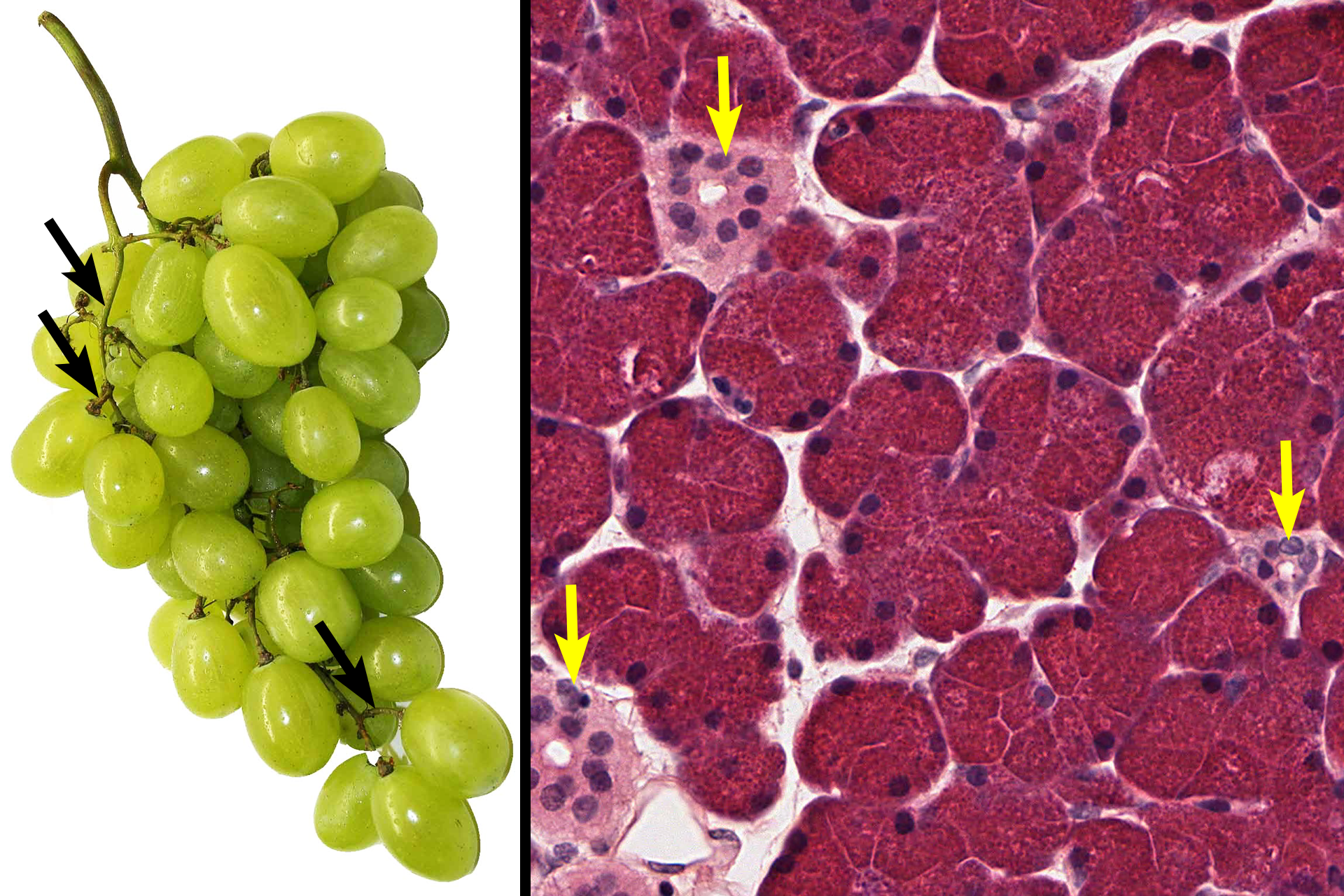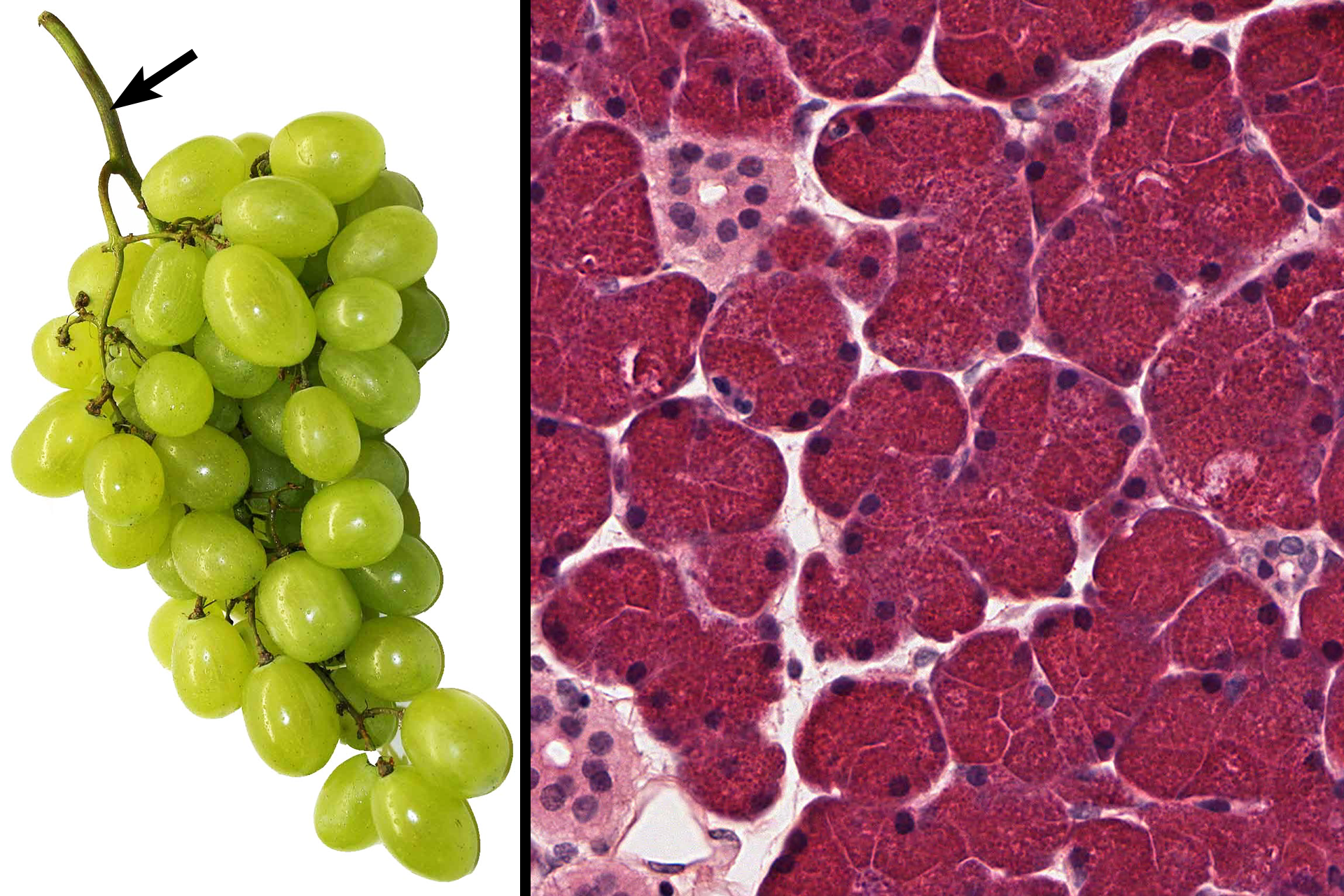
Compound acinar gland
A compound acinar gland is composed entirely of acinar (alveolar) secretory units. Each spherical acinus is composed of cells with prominent, spherical nuclei and numerous secretory granules. The lumen of each acinus is very narrow, appropriate for the thin, watery secretion of the acinar cells. Numerous intralobular ducts are also visible. Parotid gland 400x

Acini
A compound acinar gland is composed entirely of acinar (alveolar) secretory units. Each spherical acinus is composed of cells with prominent, spherical nuclei and numerous secretory granules. The lumen of each acinus is very narrow, appropriate for the thin, watery secretion of the acinar cells. Numerous intralobular ducts are also visible. Parotid gland 400x

- Nuclei of secretory (acinar) cells
A compound acinar gland is composed entirely of acinar (alveolar) secretory units. Each spherical acinus is composed of cells with prominent, spherical nuclei and numerous secretory granules. The lumen of each acinus is very narrow, appropriate for the thin, watery secretion of the acinar cells. Numerous intralobular ducts are also visible. Parotid gland 400x

- Secretory granules
A compound acinar gland is composed entirely of acinar (alveolar) secretory units. Each spherical acinus is composed of cells with prominent, spherical nuclei and numerous secretory granules. The lumen of each acinus is very narrow, appropriate for the thin, watery secretion of the acinar cells. Numerous intralobular ducts are also visible. Parotid gland 400x

- Lumens of acini
A compound acinar gland is composed entirely of acinar (alveolar) secretory units. Each spherical acinus is composed of cells with prominent, spherical nuclei and numerous secretory granules. The lumen of each acinus is very narrow, appropriate for the thin, watery secretion of the acinar cells. Numerous intralobular ducts are also visible. Parotid gland 400x

Intralobular ducts
A compound acinar gland is composed entirely of acinar (alveolar) secretory units. Each spherical acinus is composed of cells with prominent, spherical nuclei and numerous secretory granules. The lumen of each acinus is very narrow, appropriate for the thin, watery secretion of the acinar cells. Numerous intralobular ducts are also visible. Parotid gland 400x

Structure of compound acinar gland >
The structure of a compound acinar gland is analogous to the organization of a bunch of grapes. Each bunch represents a lobule with individual grapes corresponding to acini. Smaller stems connecting to the grapes denote intralobular ducts with the larger stems representing the interlobular duct. It’s helpful to keep this similarity in mind when interpreting tissue sections of compound glands.

- Acini
The structure of a compound acinar gland is analogous to the organization of a bunch of grapes. Each bunch represents a lobule with individual grapes corresponding to acini. Smaller stems connecting to the grapes denote intralobular ducts with the larger stems representing the interlobular duct. It’s helpful to keep this similarity in mind when interpreting tissue sections of compound glands.

- Intralobular ducts
The structure of a compound acinar gland is analogous to the organization of a bunch of grapes. Each bunch represents a lobule with individual grapes corresponding to acini. Smaller stems connecting to the grapes denote intralobular ducts with the larger stems representing the interlobular duct. It’s helpful to keep this similarity in mind when interpreting tissue sections of compound glands.

- Interlobular ducts
The structure of a compound acinar gland is analogous to the organization of a bunch of grapes. Each bunch represents a lobule with individual grapes corresponding to acini. Smaller stems connecting to the grapes denote intralobular ducts with the larger stems representing the interlobular duct. It’s helpful to keep this similarity in mind when interpreting tissue sections of compound glands.
 PREVIOUS
PREVIOUS